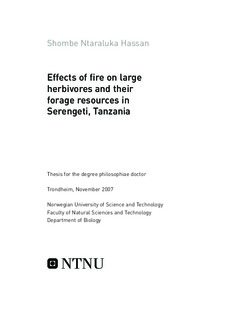| dc.contributor.author | Hassan, Shombe Ntaraluka | nb_NO |
| dc.date.accessioned | 2014-12-19T13:11:13Z | |
| dc.date.available | 2014-12-19T13:11:13Z | |
| dc.date.created | 2008-01-02 | nb_NO |
| dc.date.issued | 2007 | nb_NO |
| dc.identifier | 123145 | nb_NO |
| dc.identifier.isbn | 978-82-471-5319-2 | nb_NO |
| dc.identifier.uri | http://hdl.handle.net/11250/244575 | |
| dc.description.abstract | Fire is one of the major ecological factors that determines structure and function of grassland and savanna ecosystems through its effects on soil nutrient pools, floristic composition and primary production, and foraging behaviour and distribution of populations of wildlife species. Therefore, some wildlife protected area authorities in African savannas have a fire management scheme to cater for a variety of purposes such as, to prevent bush encroachment into grassland, to increase production of quality forage, to control wild fires from outside the protected areas and their spread, and to keep animals in tourist areas for visitors’ enjoyment. The responses to fire of ecosystem processes can be quantified but the outcomes are generally complex depending on the nature of the fire regime, primarily the frequency and timing of the fire events. For example, while ash after fire may have a fertilising effect that will facilitate seedling establishment and increase the growth and production, there is evidence that in East Africa, fire may lead to the dominance of a few species over several other species. Fire may also lead to loss of nutrients, for example nitrogen, through volatilisation. Such variaty in responses to fire makes the use of fire as a tool in the management of wildlife and protected areas usually controversial. Therefore, the main challenge of management is to strike a fire management regime as close as possible to a natural fire regime in this ecosystem.
In the Serengeti ecosystem, fire has been regarded to have a critical role on herbivores and their forage resources. Thus, burning has been a management tool in protected areas and a common practice of range management by pastoralists. Herdsmen use fire to improve the pasture quality for cattle. Removal of old or dead grass material by fire enhances sprouting of plants, which improves, at least for a short-term, the quality of the sward. In the Serengeti National Park, early dry-season burns had been executed by the Serengeti Ecological Monitoring Program Department from end of May to mid August without clear understanding about grassland responses to the prescribed burns.
The perceived importance of fire to the management and conservation of Serengeti ecosystem has driven this thesis to focus on the effects of fire on large herbivores and their forage resources in the Serengeti National Park. To accomplish that, the thesis examines the relationships between burning and 1) above ground net primary productivity in relation to sward structure and precipitation (Paper I), 2) forage quality, i.e. the concentration of macronutrients (N, P, K, Na, Mg and Ca), in vitro organic matter digestibility and levels of acid detergent fibre per phytomass component (Paper II), and 3) the temporal and spatial patterns of herbivores’ consumption (Paper III), and 4) the patch selection by ungulate species, individually and/or grouped in diet groups (Paper IV).
The result of the early dry season burns is a significantly higher daily above ground net primary production (ANPP) on burnt plots at early post-fire stages, coinciding with the dry season (July-September) and during the short rainy period (October-December). Though not significantly different, it was also high on burnt plots at the end of the main rain period (March – May), but higher on non-burnt plots in December-February, and in early dry season, June- July of the subsequent year.
Results from this area with high diversity of large herbivore species show that grazing herbivores switch between burnt and non-burnt patches by trading off between forage quantity and quality along growing season. The quality on burnt areas appears to be governed by enhanced concentrations of macronutrients, increased digestibility and reduced concentration of acid detergent fibres. The above quality variables are linked to increased ratio between live and total phytomass. Quality of forage explains the preference by grazing animals for burnt areas during some periods, and in non-burnt areas due to high phytomass in other periods.
Selection for non-burnt or burnt patches or against patches burnt more than once in a period of three years by some species of ungulates and/or diet groups are also indicative that quality and/or quantity of forage in the respective patch underlay patch choice. The cause of temporal variation in selectivity of the patches needs further investigation. However, it is unequivocal that maintenance of mosaic of burnt and non-burnt areas with adequate provision of forage amount and quality all year round is of paramount importance. | nb_NO |
| dc.language | eng | nb_NO |
| dc.publisher | Fakultet for naturvitenskap og teknologi | nb_NO |
| dc.relation.ispartofseries | Doktoravhandlinger ved NTNU, 1503-8181; 2007:239 | nb_NO |
| dc.relation.haspart | Hassan, Shombe Ntaraluka; Rusch, Graciela M.; Hytteborn, Håkan; Kikula, Idris; Skarpe, Christina. Primary production responses to early dry-season burns in western Serengeti grasslands. . | nb_NO |
| dc.relation.haspart | Hassan, Shombe Ntaraluka; Skarpe, Christina; Rusch, Graciela M.; Kikula, Idris; Hytteborn, Håkan. Forage quality of the grasses from burnt and non-burnt areas in western Serengeti, Tanzania. . | nb_NO |
| dc.relation.haspart | Hassan, Shombe Ntaraluka; Rusch, Graciela M.; Stokke, Sigbjørn; Skarpe, Christina; Røskaft, Eivind; Hytteborn, Håkan. Fire history and herbivore patch selectivity in Serengeti, Tanzania. . | nb_NO |
| dc.title | Effects of fire on large herbivores and their forage resources in Serengeti, Tanzania | nb_NO |
| dc.type | Doctoral thesis | nb_NO |
| dc.contributor.department | Norges teknisk-naturvitenskapelige universitet, Fakultet for naturvitenskap og teknologi, Institutt for biologi | nb_NO |
| dc.description.degree | PhD i biologi | nb_NO |
| dc.description.degree | PhD in Biology | en_GB |
